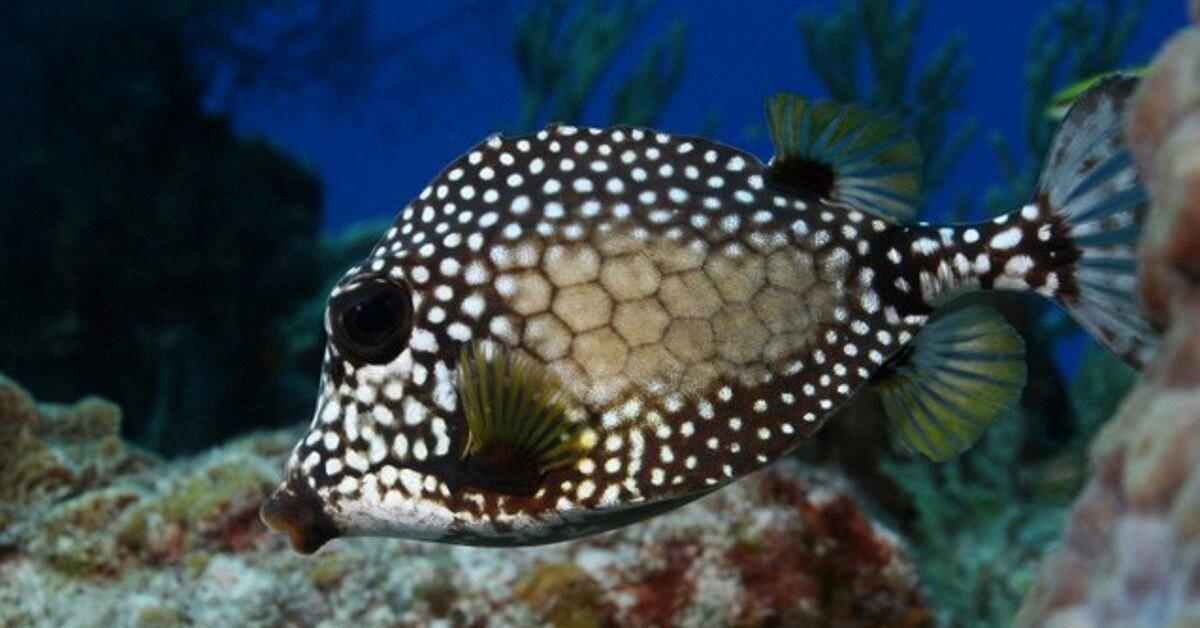The spotted trunkfish, scientifically known as Lactophrys punctatus, is a fascinating and unique marine creature that can be found in the western Atlantic Ocean. Belonging to the genus Lactophrys, the trunkfish species are known for their intriguing defense mechanism and distinct physical characteristics.
One of the most notable features of the spotted trunkfish is its hard outer shell, which provides excellent protection against potential predators. This shell, combined with sharp spines guarding its rear fins, creates a formidable defense system. These adaptations help deter larger predators, including nurse sharks, from attacking or consuming the trunkfish.
In addition to its physical defenses, the spotted trunkfish possesses another remarkable weapon in its arsenal – a toxin. This colorless toxin is secreted from glands on the trunkfish’s skin when it is touched. While the toxin is harmless to humans and other divers, it can prove fatal to predators that ingest it. This unique defense mechanism serves as a deterrent to potential predators, ensuring the survival of the trunkfish.
Smooth trunkfish, a close relative of the spotted trunkfish, are known to inhabit coral reefs and sandy seabeds at depths of approximately 50 meters. They thrive in warmer waters, typically ranging from 72 to 79 degrees Fahrenheit. This species has a wide range, spanning from Canada in the north to Brazil in the south. They can be found in various locations, including the Caribbean, Gulf of Mexico, and Bermuda.
The trunkfish’s ability to adapt to different environments and withstand a range of temperatures has contributed to its widespread distribution. Their presence in these diverse regions makes them an important component of the marine ecosystem.
While the spotted trunkfish and its relatives possess intriguing defense mechanisms and physical characteristics, further research is needed to fully understand their behavior and ecological impact. Scientists and marine enthusiasts continue to study these fascinating creatures in order to unlock the secrets of their survival and thriving in the ocean.
The spotted trunkfish is an intriguing marine creature that has developed unique defense mechanisms to protect itself from predators. Its hard outer shell, sharp spines, and secretion of a colorless toxin all contribute to its survival in the ocean. Additionally, its ability to adapt to various environments and tolerate a range of temperatures has allowed it to thrive in the western Atlantic Ocean. The study of these trunkfish species continues to provide valuable insights into the intricate workings of marine ecosystems.
Is Spotted Trunkfish Poisonous?
The spotted trunkfish, like other trunkfish in the Lactophrys genus, is indeed poisonous. It secretes a colorless toxin from glands on its skin when it is touched. However, it is important to note that the toxin is only dangerous when ingested. Divers who come into contact with the spotted trunkfish will not experience any immediate harm.
The poison produced by the spotted trunkfish and other trunkfish in its genus can be lethal to predators that consume them. Even large predators such as nurse sharks can die as a result of ingesting a trunkfish. This is because the toxin is potent enough to cause serious harm when it enters the digestive system of the predator.
It is worth mentioning that the poison secreted by the spotted trunkfish is not immediately harmful to humans. However, it is always advisable to exercise caution and avoid touching or ingesting any marine organism unless you are certain of its safety.
The spotted trunkfish is poisonous and secretes a colorless toxin from glands on its skin. While it poses no immediate danger to divers, predators that consume the trunkfish can suffer fatal consequences.

Can You Eat A Spotted Trunkfish?
It is possible to eat a spotted trunkfish, but it is important to exercise caution due to the toxins it secretes. The spotted trunkfish has a hard outer shell and sharp spines that protect it from predators. In addition, it secretes a colorless toxin from glands on its skin when touched. This toxin is only dangerous when consumed, so it is not recommended to eat a spotted trunkfish unless proper precautions are taken.
When preparing a spotted trunkfish for consumption, it is necessary to remove the outer shell and spines to avoid any injuries. It is also important to thoroughly clean the fish to remove any traces of toxin from its skin. This can be done by rinsing the fish with water and gently scrubbing its skin. It is advisable to wear gloves while handling the fish to prevent any accidental contact with the toxin.
After cleaning, the spotted trunkfish can be cooked using various methods such as grilling, frying, or baking. It is essential to ensure that the fish is cooked thoroughly to destroy any remaining toxins. Overcooking the fish is generally recommended to be on the safe side.
It is important to note that consuming a spotted trunkfish is not a common practice, and it is not widely available as a food source. It is primarily found in tropical waters and is more commonly observed in aquariums due to its unique appearance.
While it is possible to eat a spotted trunkfish, it is crucial to take necessary precautions to remove the toxins and ensure proper cooking. It is advisable to approach this with caution and consult experts or local guidelines before attempting to consume this fish.
Where Do Smooth Trunkfish Live?
Smooth trunkfish can be found in various habitats in the western Atlantic Ocean. They are known to inhabit both coral reefs and sandy seabeds, where they make their homes at a depth of around 50 meters. These fish have a wide range, extending from as far north as Canada to as far south as Brazil. This includes the waters of the Caribbean, Gulf of Mexico, and Bermuda. The preferred water temperature for smooth trunkfish ranges between 72 and 79 degrees Fahrenheit. Their ability to adapt to different environments allows them to thrive in diverse locations within their range.
Conclusion
The trunkfish, specifically the spotted trunkfish, is a fascinating species that possesses unique adaptations for survival. Its hard outer shell and sharp spines provide excellent protection against predators, while its ability to secrete a colorless toxin adds an extra layer of defense. This toxin is harmless to divers but can be deadly when ingested by predators such as nurse sharks. The trunkfish can be found in coral reefs and sandy seabeds at depths of around 50 meters, primarily in warmer waters ranging from 72 to 79 degrees F. Its range extends from Canada to Brazil, including various regions in the western Atlantic Ocean such as the Caribbean, Gulf of Mexico, and Bermuda. the trunkfish showcases remarkable adaptations and serves as an intriguing example of nature’s diversity and ingenuity.












